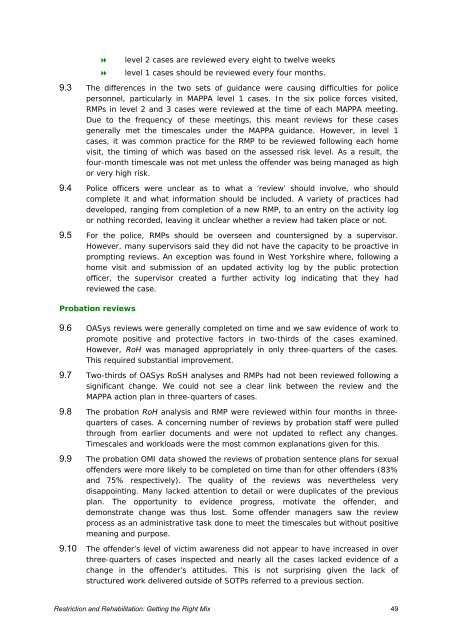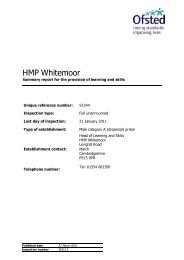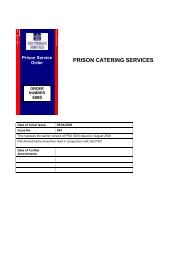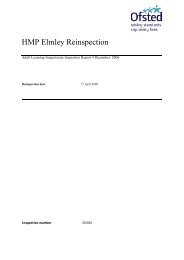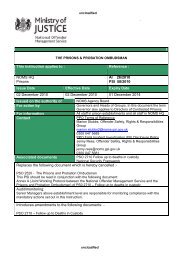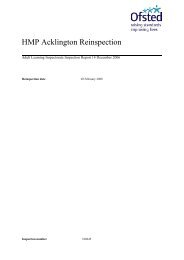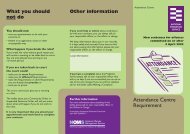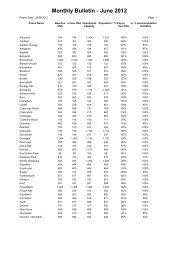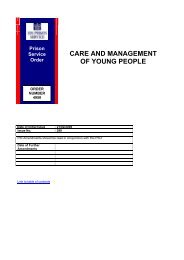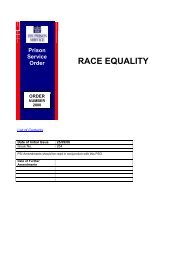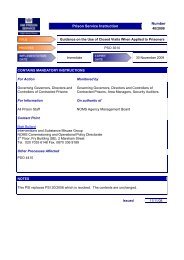Restriction and Rehabilitation: Getting the Right ... - Ministry of Justice
Restriction and Rehabilitation: Getting the Right ... - Ministry of Justice
Restriction and Rehabilitation: Getting the Right ... - Ministry of Justice
You also want an ePaper? Increase the reach of your titles
YUMPU automatically turns print PDFs into web optimized ePapers that Google loves.
level 2 cases are reviewed every eight to twelve weeks<br />
level 1 cases should be reviewed every four months.<br />
9.3 The differences in <strong>the</strong> two sets <strong>of</strong> guidance were causing difficulties for police<br />
personnel, particularly in MAPPA level 1 cases. In <strong>the</strong> six police forces visited,<br />
RMPs in level 2 <strong>and</strong> 3 cases were reviewed at <strong>the</strong> time <strong>of</strong> each MAPPA meeting.<br />
Due to <strong>the</strong> frequency <strong>of</strong> <strong>the</strong>se meetings, this meant reviews for <strong>the</strong>se cases<br />
generally met <strong>the</strong> timescales under <strong>the</strong> MAPPA guidance. However, in level 1<br />
cases, it was common practice for <strong>the</strong> RMP to be reviewed following each home<br />
visit, <strong>the</strong> timing <strong>of</strong> which was based on <strong>the</strong> assessed risk level. As a result, <strong>the</strong><br />
four-month timescale was not met unless <strong>the</strong> <strong>of</strong>fender was being managed as high<br />
or very high risk.<br />
9.4 Police <strong>of</strong>ficers were unclear as to what a ‘review’ should involve, who should<br />
complete it <strong>and</strong> what information should be included. A variety <strong>of</strong> practices had<br />
developed, ranging from completion <strong>of</strong> a new RMP, to an entry on <strong>the</strong> activity log<br />
or nothing recorded, leaving it unclear whe<strong>the</strong>r a review had taken place or not.<br />
9.5 For <strong>the</strong> police, RMPs should be overseen <strong>and</strong> countersigned by a supervisor.<br />
However, many supervisors said <strong>the</strong>y did not have <strong>the</strong> capacity to be proactive in<br />
prompting reviews. An exception was found in West Yorkshire where, following a<br />
home visit <strong>and</strong> submission <strong>of</strong> an updated activity log by <strong>the</strong> public protection<br />
<strong>of</strong>ficer, <strong>the</strong> supervisor created a fur<strong>the</strong>r activity log indicating that <strong>the</strong>y had<br />
reviewed <strong>the</strong> case.<br />
Probation reviews<br />
9.6 OASys reviews were generally completed on time <strong>and</strong> we saw evidence <strong>of</strong> work to<br />
promote positive <strong>and</strong> protective factors in two-thirds <strong>of</strong> <strong>the</strong> cases examined.<br />
However, RoH was managed appropriately in only three-quarters <strong>of</strong> <strong>the</strong> cases.<br />
This required substantial improvement.<br />
9.7 Two-thirds <strong>of</strong> OASys RoSH analyses <strong>and</strong> RMPs had not been reviewed following a<br />
significant change. We could not see a clear link between <strong>the</strong> review <strong>and</strong> <strong>the</strong><br />
MAPPA action plan in three-quarters <strong>of</strong> cases.<br />
9.8 The probation RoH analysis <strong>and</strong> RMP were reviewed within four months in threequarters<br />
<strong>of</strong> cases. A concerning number <strong>of</strong> reviews by probation staff were pulled<br />
through from earlier documents <strong>and</strong> were not updated to reflect any changes.<br />
Timescales <strong>and</strong> workloads were <strong>the</strong> most common explanations given for this.<br />
9.9 The probation OMI data showed <strong>the</strong> reviews <strong>of</strong> probation sentence plans for sexual<br />
<strong>of</strong>fenders were more likely to be completed on time than for o<strong>the</strong>r <strong>of</strong>fenders (83%<br />
<strong>and</strong> 75% respectively). The quality <strong>of</strong> <strong>the</strong> reviews was never<strong>the</strong>less very<br />
disappointing. Many lacked attention to detail or were duplicates <strong>of</strong> <strong>the</strong> previous<br />
plan. The opportunity to evidence progress, motivate <strong>the</strong> <strong>of</strong>fender, <strong>and</strong><br />
demonstrate change was thus lost. Some <strong>of</strong>fender managers saw <strong>the</strong> review<br />
process as an administrative task done to meet <strong>the</strong> timescales but without positive<br />
meaning <strong>and</strong> purpose.<br />
9.10 The <strong>of</strong>fender’s level <strong>of</strong> victim awareness did not appear to have increased in over<br />
three-quarters <strong>of</strong> cases inspected <strong>and</strong> nearly all <strong>the</strong> cases lacked evidence <strong>of</strong> a<br />
change in <strong>the</strong> <strong>of</strong>fender’s attitudes. This is not surprising given <strong>the</strong> lack <strong>of</strong><br />
structured work delivered outside <strong>of</strong> SOTPs referred to a previous section.<br />
<strong>Restriction</strong> <strong>and</strong> <strong>Rehabilitation</strong>: <strong>Getting</strong> <strong>the</strong> <strong>Right</strong> Mix 49


